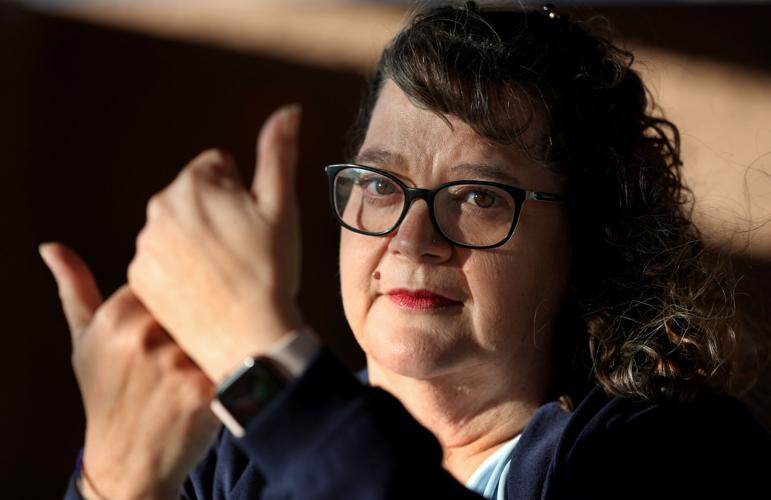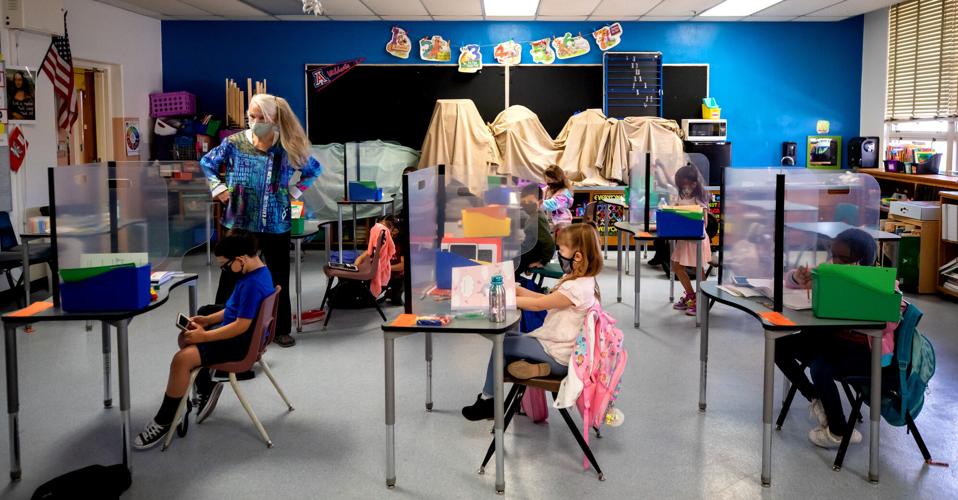The past several months have been the most difficult of her career for Sjana Summons, an American Sign Language teacher at Amphitheater High School, and she is not alone in that feeling.
“I don’t think any of us are prepared for the amount of needs that (our students) are bringing to us — not just educational needs, but literal needs, like we’re in the bottom tier of the triangle of Maslow,” she said, referring to basic survival needs such as food, shelter and clothing.
“I put myself, as all the other teachers that I know, on the back burner, and we’re really reaping the ricocheting repercussions from that because we’re really burned out,” she said.
David Richter said his main emotion while driving into work each morning is stress. He is an exceptional education teacher who covers the K-2 autism program at Drachman Montessori K-8 Magnet School.
“It’s always a little bit of a juggling act, trying to figure out how we’re going to cover all the things we need to do in one day because sometimes it’s like, who’s going to be there?” he said.
School districts across Pima County have been struggling with low teacher staffing levels since the beginning of the 2021-2022 academic year, often resulting in heavier workloads for the present teachers.
On top of that, schools experienced unusually high teacher absences during the surge of COVID-19 infections last month, combined with a shortage of available substitute teachers.
Administrators have been amping up efforts to try to keep their teachers and prevent even deeper staffing shortages next academic year.
But those retention efforts come as teachers are already feeling burned out and overwhelmed by the trauma of the pandemic and the stress of not knowing, day to day, if there will be enough staff to fill classrooms.
Staffing shortages
Tucson Unified School District — the largest in the county, and which includes the Drachman Montessori school — had a total of 2,447 teachers throughout the district at the beginning of the 2021-2022 school year, according to information provided by the district.
That was lower than the 2,635 teachers who were employed during the 2018-2019 school cycle, the last normal year before the pandemic.
“This really is a nationwide labor shortage, and it’s not anything that we’ve ever seen before,” said Renee Heusser, the executive director of TUSD’s human resources department. “We don’t have a toolbox full of ways to handle it.
“It’s thrown us into a whole different world that we’re all learning how to live in.”
Administrators in Sunnyside and Amphitheater school districts, the second- and third-largest in the county, are also trying to retain teachers and attract new employees.
Heusser and Debra Bergman, chief human resources officer for Sunnyside, cited a myriad of reasons why some employees decided to leave their jobs.
Some, Heusser said, were close to retirement when COVID-19 hit in early 2020 and decided it was in their best interest to retire a bit sooner. Others, Bergman said, might have “shopped around” and found other jobs with more attractive salaries and schedules.
“I think COVID has really caused people to do deep reflection on ‘what is it that I want to do in the future for the rest of my life,’” Bergman said.
Statewide, as of January, nearly 2,000 teacher positions were vacant and 944 teachers had resigned since the start of the school year, according to the Arizona School Personnel Administrators Association’s annual survey, Cronkite News reported this week.
Repercussions
The staffing shortages have been felt in the daily operations of schools throughout the county.
“I’ve seen our counselor have to go in and fill classrooms, not mine, but others. I’ve seen our behavior specialist go in and fill classrooms,” Richter said. “It’s been very interesting to see how creative we’ve had to be to fill classrooms this year.”
Teachers sometimes have to take over a subject that’s not of their expertise. Summons, the sign language teacher in her sixth year of teaching at Amphi, covered an orchestra class, for example. Luckily, she said, the teacher had left a lesson for the students to work on.
Summons said she is happy to help out her fellow teachers and care for the students outside of her own class time. But it is not a sustainable practice, she said, as it takes away most of her planning time for her upcoming classes.
For Richter, the staffing shortage has meant having much less help during his own classes. He said he used to count on the help of three to four classroom aides at Morgan Maxwell K-8 School, where he taught the previous year.
This year, however, he has only one classroom aide to assist with responsibilities that include tending to students’ medical needs.
“That makes it virtually impossible to send one aide out to assist a kid, unless I’m in the room with five to nine autistic kids by myself,” Richter said. “To say that’s difficult would be an understatement.”
Summons added that the lack of a single social worker at Amphitheater High School has also made it more difficult to care for her students. She said teachers can ask for assistance from social workers at other campuses, but she felt she needed more than that to address the needs of her students.
“This year alone, I’ve had so many students who’ve lost a parent,” she said, noting that she didn’t know how to help her students through that level of grief and trauma.
“I will say that (the district) is trying to help us with social-emotional learning, but we need more than a 15-minute video. Our kids need more than that.”
Summons also noted that it was an added stress to think about what would happen if she became sick with COVID, considering teachers now have to use their personal sick time while they recovered.
Stipends
During the 2021-’22 academic year, the three largest school districts in Pima County have mainly turned to distributing retention stipends to employees across the board to compensate them for their efforts during the trying times.
And moving forward, district administrators plan to continue those monetary compensation efforts.
Heusser said that last fall, TUSD gave out a $1,200 stipend to employees who had worked the previous year and returned for the 2021-’22 school year.
She added that officials were looking to distribute another similar payment for employees who continued through the spring semester, and officials were discussing another compensation package for employees who return next school year.
At Sunnyside, the governing board approved paying all employees a $1,500 stipend that was distributed in two increments last fall.
During its Feb. 8 meeting, the board postponed discussing an agenda item regarding retention and recruitment incentives that included monetary compensation for employees who renewed their contracts. The postponement was due to uncertainty about funding related to a state spending limit issue.
Amphitheater governing board members previously approved an employee retention stipend totaling 3% of the employees’ wages, which the district distributed in two increments in September and January. The board then approved bumping the stipend up to 4% upon the employees’ return next year.
Michelle Tong, associate to the superintendent and general counsel in the Amphitheater district, said other retention efforts administrators have enacted include social-emotional training programs to help students and teachers — an effort several districts in Pima County have implemented in recent years.
Tong said the district has also reclassified a few positions throughout the district to better support individual schools in midst of the staffing shortage.
“We have been very innovative about trying to work closely with staff to make sure that they know they are valued, that they know that they have a voice to be able to say if they need assistance,” she said.
Richter of TUSD said that while teachers still need support in more ways than economic incentives, it was still nice to receive the extra money, and he wasn’t sure he had a better solution.
Summons, who renewed her teaching contract with Amphi this month, agreed the stipends were a good way for the district to show appreciation for its employees.
But, the true reasons for renewing her contract were based on her passion for teaching her students and the employment stability that her position offered.
“All of the teachers at Amphi High want to teach at Amphi High School. They’re not there for the paycheck,” she said. “Every single one of my colleagues has a drive to service these kids, and that’s what keeps us coming back to work.”





